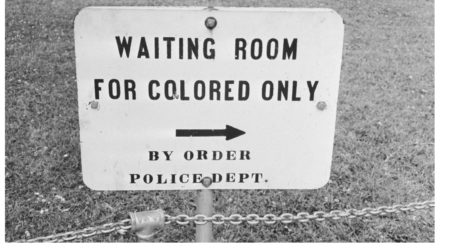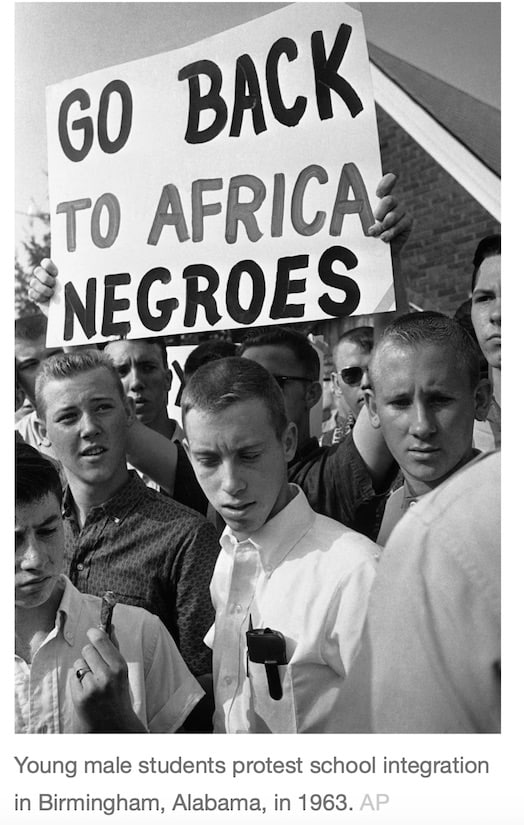
They shoot cats, don’t they?
Pictured above: A sign in Jackson, Mississippi, dated 1961 (Photo: William Lovelace/ Express/Houlton Archive/Getty Images)
This article first appeared in Malta Today
The compilation of evidence against the two soldiers accused of allegedly killing Lassana Cisse, as well as the attempted murder of two other men from Ghana and a hit-and-run involving yet another migrant from Chad, started on Friday. What has emerged so far has revealed some very chilling, disturbing facts about the two young men.
Perhaps the most unsettling piece of information was that they shot at these people and killed Cisse, an immigrant from the Ivory Coast, because they had failed to find any cats to shoot at, something which they apparently did on a regular basis.
So, it seems that when they did not find any animals to use as target practice, they decided to use live human beings instead, indulging in what can only be described as a shooting spree which left one man dead and two other men seriously injured.

Random drive-by shootings are rare in Malta – the most infamous one probably being that of Raymond Caruana who was in the wrong place at the wrong time when shots were fired at a PN club from a passing vehicle in the 1980s. His killers have never been found.
Tragically, Cisse too was at the wrong place at the wrong time. We have all become used to the sight of African immigrants walking from one part of the island to the other, because many do not have any means of transport. So here was this quiet, hard-working man, listening to music on his headphones as he was making his way home on foot to Birzebbugia at the dead of night. The two other men who were injured, were also on their way home after watching a football match. A car passed by, and one of the culprits shot Cisse in the head, killing him instantly. They then saw the two other migrants and shot at them as well, but luckily they survived.
In Court, a police inspector testified that “the suspect had told Police they would sometimes drive through Ħal Far and hurl verbal abuse at migrants”. He also admitted to Police that on another occasion they had swerved their car to deliberately hit a migrant who was walking along the road.
I am not repeating these details merely for their shock value (although they are indeed, deeply shocking) but to point out that from what was revealed in Court, the behaviour of these two soldiers seemed to be following a certain pattern, which gradually escalated and reached a tragic climax on the night of 6 April.
First, their blanket hatred of all migrants was expressed both verbally (according to the girlfriend of one of the men) and online. In fact, one of the charges against them relates to the racist speech they had posted on social media.
Meanwhile, they had a penchant for guns and for shooting at stray cats, which also coincided with them joining the Army.
Next, they started actively seeking out areas where migrants were known to pass from (between Hal Far and Birzebbugia) in order to hurl verbal abuse at them. This was not enough because the next step was to allegedly run a migrant from Chad over, in a hit-and-run incident which left him hospitalised.
Finally, and horrifically, their behaviour spiralled into what for most of us is unthinkable: the alleged murder of an innocent man who just happened to be passing by. The description of how that fateful night unfolded reminded me of some violent video game, or else the type of drive-by shootings (unfortunately) common in the States when someone gets hold of a gun and starts shooting indiscriminately at bystanders. But because the victims are black and there is no evidence of them being involved in any trouble which could otherwise explain the attack, the parallels with the ugly racial hatred in the Deep South during the 50s and 60s is also too blatant to ignore. In fact, yet another separate charge is that the motive behind the murder was racism.
If you watch any documentary or film portraying one of the worst periods in American history, you will notice how the racially-charged slurs, the intimidation, the humiliation, the psychological and eventually the physical violence are a steady progression as those who feel they can get away with it, are emboldened at every step. The bravado also increases when the culprits gang up together in numbers – you would hardly see a white man taking on two black men at the same time, but twist the numbers around and two white men would find it relatively easy to harass, ridicule and possibly beat up one black man on his own. This is precisely why racist language and hate speech on social media are so dangerous: if you think you are the only one feeling like this, you might take a step back, but if you see hundreds or even thousands repeating the same sentiments, that is enough to put some wind in your sails (or as we like to say colloquially, “taghmel l-arja”), secure and smug in the knowledge that you are not alone.
Some might think that mere words or comments are harmless and that “everyone has the right to an opinion”; but when it comes to fomenting hatred against a specific group of people it is such a slippery slope and can cause such irreparable harm to society that what start off as small ripples can turn into waves of damage which are unstoppable. To use an example which many can relate to: how does it feel when someone loathes and despises you with an uncontrollable, visceral hatred purely because you vote Labour or vote Nationalist? Who has never heard the expressions DAK Laburist jinten or DIK Nazzjonalista hadra, spoken in scathing tones of deep contempt? (For my non-Maltese readers those expressions translate to ‘that filthy Labour supporter’ and ‘that despicable Nationalist”). It hurts, right? It’s completely unfair, unacceptable and reduces you to a label rather than a living human being who is much more than the political party they vote for.
Well, transpose that with reference to race, and you can begin to understand why disparaging words directed at people simply because they have a different skin colour has no place in a civilised society. It is also clear that hateful words can and do lead to incitement; they can trigger those who are so inclined to act upon their feelings of anger and rage towards a specific group, propelling them to do things which are much worse than merely posting a FB comment.
Another point which cannot go unnoticed is the correlation between hurting and killing innocent animals and violence towards human beings. According to Psychology Today, “Studies carried out by Dr. Phillip Kavanagh and his colleagues have examined the relationship between the three Dark Triad personality traits and attitudes towards animal abuse and self-reported acts of animal cruelty. They found that the psychopathy trait is related to intentionally hurting or torturing animals, and was also a composite measure of all three Dark Triad traits (Machiavellianism, narcissism, and psychopathy).”
Because they are so defenceless, many feel that the harming of animals is an atrocity they cannot tolerate – but how much worse is it that, after failing to find a cat to shoot at, one decides to shoot at another human being instead? This thought process seems to further underline the fact that, for the person who pulled the trigger, someone who is black is so dehumanised in their mind that his life is as worthless and meaningless as that of a “mere” stray cat.
Finally, the fact that the two soldiers accused of this crime are aged 21 and 22, has sent a wave of horror throughout the country. Apart from the fact that they were in the Armed Forces (which is a separate issue which would require another column) how can those who are so young already have it in them to be so callous and unfeeling? The lack of empathy and compassion in society, especially among our youth, is something we need to seriously address before we find ourselves being faced by a generation which has utterly lost the ability to care about anything or anyone.
- May 28, 2019 No comments Posted in: Opinion column Tags: murder, soldiers





